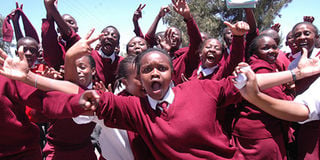Alliance boys and Precious Blood top

Joseph Kiheri | NATION
Moi Kabarak High School students celebrate February 28, 2011, after the institution produced the best student in last year’s KCSE exams, Albert Wandui Kamau.
What you need to know:
- Starehe out of top 10
- Provincial schools take national ranks 2, 3, and 4
- Girls missing in the top rankings
- Private schools dominate top 100
- Maranda shines in Nyanza and Sheikh Khalifa tops Coast.
Alliance High School topped last year’s Form Four exam results, which were released on Monday, with a performance index of 11.2570 out of a possible 12.
But Albert Kamau Wandui of Moi High School Kabarak was the best Kenya Certificate of Secondary School (KCSE) candidate with a performance index of 87.10357.
The best girl was Lydia Katini Mwangasha of Kenya High who had a performance index of 87.04229 but ranked fifth overall.
In the school ranking, reintroduced after a six-year hiatus, Precious Blood Riruta, a perennial top performer run by Catholic nuns, was second, with a performance index of 11.0106 and was followed in third place by Bahati Girls, another Catholic school. Fourth was Nyanza’s Maranda High School, which had the double distinction of posting the best results in Kiswahili and CRE nationally.
Alliance Girls High School came fifth, while Moi High Kabarak was sixth and followed by Moi Girls High School Eldoret in seventh place. Kenya High was eighth while new-comer Starehe Girls was ninth and Strathmore School completed the list of the top 10.
Private schools
In the list of the candidates, the second best was Allan Machuka Marube of Alliance High School, scoring 87.08986. The third position went to Joshua Obinchu Getega of Maranda (87.08900) and was followed by Brian Mulu Mutua of Alliance (87.04914) in fourth berth.
Lydia Katini Mwangasha of Kenya High was ranked fifth overall. She was the top girl nationally. Others in positions six to 10 were: Andrew Kabucho Mwangi of Moi High School Kabarak, Felix Ochieng Ogola of Kanga, Lesley Owuor Opere (Alliance) Newnex Brian Monga’re (Moi High School Kabarak and Ivy Muthoni Macharia (Kenya High).
Also notable was the rise of private schools, which featured prominently among the best 20 performers, led by Moi High School Kabarak in position six, Strathmore (11), Sheikh Khalifa (12) Kianda (13), Maasai (14), Sacho (16) and Mary Mother of Grace (17).
The results had surprises. Bahati Girls and Maranda of Nyanza made a dramatic entry to the list of best 10. But perennial top performers like Starehe Boys Centre and Mangu were dethroned from the list. Starehe ended at position 11 and Mangu was relegated to position 15. Other names like Maseno School, Nairobi, Limuru Girls also went down the ladder.
Overall, Alliance candidates dominated the list of the best 100, taking 30 places and Maranda and Kenya High six each. Moi High School Kabarak had five, Maseno (3), Precious Blood, Starehe Boys and Kanga (one each).
According to subject performance, Alliance posted the best mean score in four key subjects, namely maths, biology, chemistry and geography. Maranda High School was the star in Kiswahili and CRE while Bahati was best in English. Little-known Nyiro of the Rift Valley excelled in history; Alliance Girls in business studies and Kenya High in physics.
Alliance High School principal David Kariuki said the performance was not a surprise.
“We had prepared our candidates well and they lived according to our expectations,” he said. “Our candidates and the teachers worked hard and we got what we deserved.”
Girls’ schools made a remarkable showing in the chart ranking, taking six out of the 10 top slots. Kenya High shone in physics, a subject traditionally associated with boys.
Despite good showing by some schools, the girls are not out of the woods yet. In three out of the eight provinces, there were no girls featuring among the best 10 candidates. Moreover, among the 97,134 candidates with C+ and above, less than a third, 36,934, were girls.
“Although we have put many interventions in place to address gender gap across all provinces, disparities in favour of boys still persist in North Eastern, Nyanza and Coast provinces,” said Education minister Sam Ongeri, who released the results at the Kenya National Examinations Council headquarters in Nairobi’s Hurligham area.
Prof Ongeri, however, said performance had improved in 14 subjects, including maths, biology, chemistry, physics and CRE. This was boost for the sciences, which have generally recorded poor performance.
He attributed the improved performance in sciences to government’s grants to schools for laboratories and in-service training for science teachers.
“As a result of this improved performance, the number of candidates who obtained grade C+ and above, which is the minimum university entry qualification increased from 81,048 in 2009 to 97,134 in 2010 representing 27.17 per cent of the total candidature,” he said.
However, Prof Ongeri said teacher shortage, few science inspectors, and inadequate science labs and equipment still undermined optimum performance in the sciences.
The high number of candidates with grade C+, however, will create challenge of university admission, which, on average, absorb just a third of qualifiers.
For example, about 22,000 candidates were selected from the 2009 cohort to join the seven public universities. The private universities admit about 10,000, meaning the bulk of qualifiers may not get admission anywhere.
Cases of exam cheating dropped by half, from 1,711 in 2009 to 534. However, Prof Ongeri was concerned that cheating had mutated into different forms, including attempts by some school headteachers to bribe invigilators to allow them to give answers to candidates.




